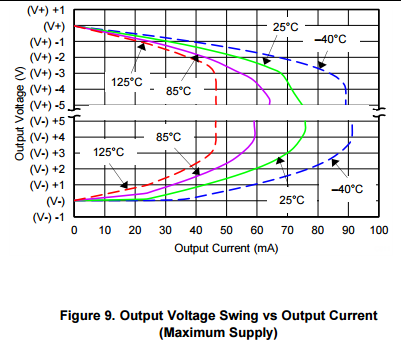Other Parts Discussed in Thread: OPA172, OPA2172
Hi All,
I am using an OPA211 for a robotics application in a non-inverting VCCS configuration and had some questions about the output current characteristics. The load is primarily inductive and resistive and also highly nonlinear. The load impedance is low enough 3.5V headroom is maintained on the positive side and 2.5V on the negative side. COMP is some frequency compensation for stability and transient response.
The datasheet indicates typical values @25C for short circuit sinking and sourcing currents (-45mA and +30mA) as well as a graph (figure 23) of how both of these values vary with temperature. Since my application will have symmetrical maximum current, I am concerned only with the lower of the two limits (in this case sourcing).
It also provides a figure relating the maximum output current to the available voltage headroom shown below:
Over let's say 0-150C temperature range the two graphs seem to suggest different sourcing capabilities:
Figure 23 would suggest ~26.5mA based on the performance right at 150C
Figure 37 would suggest ~32mA based on the 3.5V headroom I maintain, also at 150C
My first question is: what is the reason for this apparent disagreement between the two ratings? Is there a difference in input overdrive in the test conditions that I am missing?
----------------------------------------------------------------------------------------------------------------------
My second question is essentially, _roughly_ how much could I expect [whichever of the above 2 potential current ratings I should abide by] to vary from chip to chip? Since minimum and maximum values are not specified in the datasheet I was going to assume that it may vary extremely. I am not looking for any guarantees and no one's safety is riding on this circuit, just inconvenience for me. I am simply looking for a reasonable rule of thumb or ballpark guess from the actual makers of the device to help determine a sensible amount of margin to give myself in this design.
Help is much appreciated, thank you.





